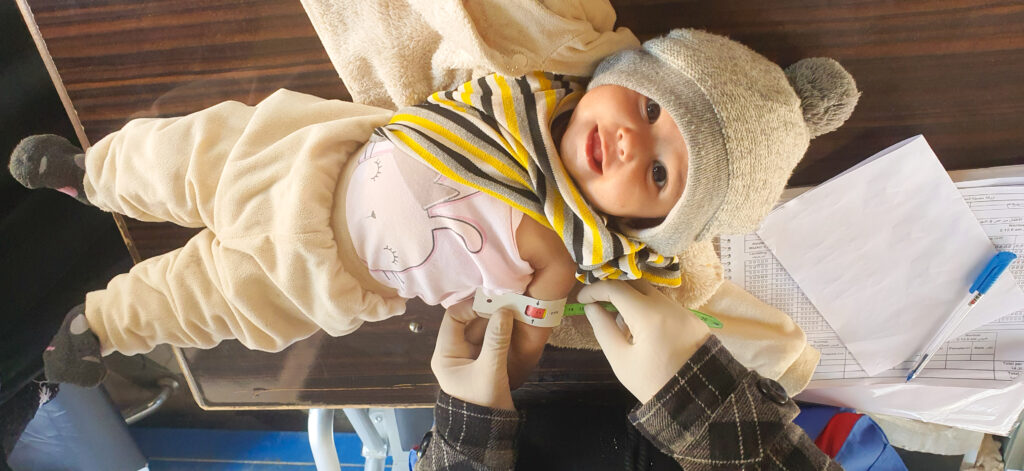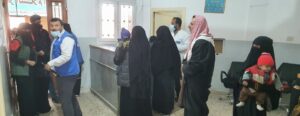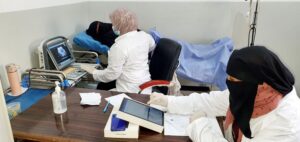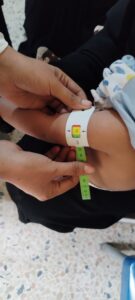
Nutrition status in Northeastern Syria:
The Syrian crises led to 5.5 million children and pregnant and lactating women(PLW) in need of life-saving preventive and curative nutrition interventions in 2022, compared with 4.9 million in 2021. Almost one in three pregnant women are anaemic while almost 90,000 children under the age of five years in Syria are acutely malnourished (HNO, 2021). The results from the only SMART Survey conducted in North-East of Syria give an alert on multiple needs in different geographical areas.
The prevalence of combined global acute malnutrition (GAM) reaches 12% in Deirez-Zor governorate and 9.4% in Al-Hasakeh governorate and based on the World Health Organization (WHO) 2018 standards, the combined GAM prevalence was classified as acceptable in Aleppo and Ar-Raqqa governates, whereas in Al-Hasakeh and Deir-ez-Zor the classification is issued as alert. The results further showed alarming levels of stunting among children, the highest in Ar-Raqqa governorate at 27.6%. Furthermore, the findings of malnutrition rates among pregnant and lactating women, especially in Deir-ez-Zoor governorate, reaching up to 20.5%.
Nutrition Sector Strategy:
IPV strategies for nutrition sector divided into the following:
- Improve access to equitable and quality curative nutrition services.
- Improve the quality and coverage of integrated malnutrition prevention nutrition services for most vulnerable groups.
- Strengthen nutrition resilience through capacity-building, proper advocacy and constant evaluation.
- Enhance the integration of nutrition sector with other sectors, mainly health, FSL and protection.
IPV is the chair of IYCF technical working group in NES forum, and Co-Chair of CMAM working group.
Sector objective
1 – The early identification and provision of treatment for children under 5 (CU5) and pregnant and lactating women.
- Conduct in-site and mobile screening activities to early detect malnourished children and pregnant and lactating women.
- Provide quality treatment services for the management of moderate “MAM” and severe wasting “SAM” among CU5, pregnant and lactating mothers through mobile teams and operating static out-patient therapeutic centers “OTP”.
- Provide in-patient treatment services for the management of sever wasting with complication among CU5, through establishing and running stabilization center “SC”.
- Deploy Rapid Response Teams “RRT”, to provide urgent nutrition services, in emergency settings.
- Enhancing innovative approaches to increase the screening capacity and the early detection for better outcomes, like family MUAC approach.
2 – Develop and implement malnutrition prevention services for Children under 5 and PLWs.
- Screen PLW and caregivers of children 0 – 24 months for infant feeding difficulties.
- Provide facility and community-based skilled different kind of counselling (one-toone, Group counselling, mother-to-mother support) on WHO-recommended Infant and Young Child Feeding in Emergencies (IYCF-E) practices.
- Establish and run Baby-Friendly Spaces/Mother-Baby Areas at community and primary health care center level, to provide support and counselling for PLWs and caregivers.
- Provide massive campaigns to raise the awareness about the proper IYCF-E practices including, through group sessions, individuals’ sessions, door to door awareness raising activities, distributing brochures, hanging posters, lunching media campaigns, using IPV different internet platform and social media channels.
- Increase awareness with local stakeholders about the Code of Breast Milk Substitute Marketing (1981), alongside monitoring and reporting of any violations of the Code.
- Provide micronutrient supplementation to PLW and children U5 including the micronutrient supplements (micronutrient powder (MNP) for children and iron, folate and Micronutrient tablets for PLWs.
3 – Strengthen the nutrition program capacity in northeast Syria.
- Strengthen technical capacities among health and nutrition workers on different nutrition programs and activities.
- Support the nutrition partners with stakeholders with the update on nutrition guidelines, CMAM, IYCF etc.
- Conduct rapid and comprehensive assessment to evaluate the nutrition status in NES, by conducting SMART and KAP surveys.
- Promote local campaigns for advocacy about the nutrition status and the priority of nutrition activities like, the breastfeeding week campaign and World Nutrition Day.
- Lunch advocacy campaigns with local and international stakeholders building on the surveys results, to attract possible stakeholder to support nutrition programs.
4 – Support the integration approach with different IPVs sector.
- Build, maintain and monitor an effective referral pathway from the nutrition program to protection program, mainly for children and PLWs at risk.
- Implement full integration between nutrition and health programs, by relying on health facilities to implement nutrition activities, training health care providers on nutrition programs and engaging them in delivering key nutrition messages and monitor best practices.
- Support the integration with FSL program through, Scaling-up Cash and Voucher Assistance interventions to improve access to and consumption of safe, adequate and dietary diversified complementary foods among vulnerable children aged 6 – 24 months and PLWs.
5 – Enhancing Disease Surveillance to Better Respond to Potential Outbreaks of Disease.
Nutrition sector main themes in IPV:
- Screening for malnutrition.
- Management of acute malnutrition cases.
- Best nutrition practices awareness and education.
- Distribution of preventive nutrition supplies.
- Capacity building.
- Evaluate by conducting surveys.





